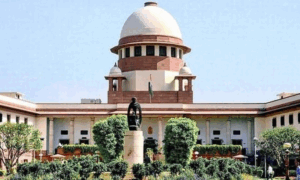
Thermal power plants take water away from other uses such as in agriculture and homes/ Source: The Third Pole
The Indian government’s policy of using treated sewage water to run operations in coal-fired power plants is not economically viable and will do little to resolve conflicts over water use
By Katherine Purvis
An ambitious plan to reduce the dependence of India’s coal-fired power plants on freshwater has stalled in its starting blocks. The policy for some plants to use treated sewage water, introduced last year, is impractical and economically nonviable, according to a recent report by Greenpeace India.
A severe drought in 2016 forced several coal plants to shut down, causing the loss of nearly 11 billion units (kWH) of power — and an estimated potential revenue of USD 560 million — between January and July 2016. The energy ministry, through a Government of India notification in January 2016, made it mandatory for all thermal power within 50 kilometres of a sewage treatment plant to use treated wastewater in their operations.
Only 8% of all coal plants in India are able to completely meet their water needs in this way, according to the Greenpeace report, “Pipe Dreams”. Some 5% of plants can partially satisfy their water needs through treated sewage, but a staggering 87% of India’s 200-gigawatt coal power plants cannot follow the policy because they have no access to treated sewage water. The report also states that less than 11% of India’s total treated sewage water can be used by thermal power plants.
Water shortages
India relies heavily on conventional sources of energy, with thermal power contributing a major proportion of all the electricity produced in the country. Acute shortages of water around power plants impact the power output. India intends to generate as much as 56.5% of its electricity from non-fossil fuel sources by 2027.
Coal-fired power plants are a major contributor to greenhouse gas emissions that lead to climate change. They use water to run turbines and for cooling, which accounts for 80% of the total consumption. Some 3.5 litres of water are needed to produce one unit of energy and across India, coal power plants use an estimated 4.6 billion cubic metres of freshwater per year, enough to meet the basic needs of 250 million people.
Location, location, location
Using treated wastewater — rather than untreated or saline water that can corrode turbines or generate biological growths that clog the machinery — would be one way for the coal industry to decrease its use of precious fresh water reserves. But sewage treatment facilities are mostly built in urban areas, away from power plants. The states of Chhattisgarh, Odisha and Madhya Pradesh, for example, jointly produce 77 gigawatts of coal power but can only supply enough treated sewage water to generate 1.5 gigawatts.
“To claim that the use of sewage would solve coal power’s water problem would be like claiming a drop of water will save a man dying of thirst,” said Jai Krishna, a Greenpeace researcher and author of the report.
In addition to the billions needed to invest in treatment facility infrastructure, the report claims that coal plants that can viably use wastewater will see water costs soar by at least 300% — a financial burden that would be passed on to customers. Taking treated sewage water out of the local ecosystem is also detrimental to downstream water flows.
In addition, states Greenpeace, the use of sewage to meet coal power plants’ cooling needs will not resolve the conflict over water between thermal power plants and farmers and urban communities.
In March 2016, the 1,700 MW Raichur thermal power station in the Krishna River basin was closed for several days due to water shortages. Farmers in the region and the neighbouring Mahbubnagar district protested when water was provided to the plant at the cost of drinking water for downstream populations. The effect of low water levels was felt dramatically when the National Thermal Power Corporation (NTPC), India’s largest power generation company, stopped production at its 2,100-megawatt Farakka plant in the eastern state of West Bengal. Water levels from the Farakka feeder canal (originating from the Ganga) to the power plant declined to such an extent that the plant was forced to switch off its 500-megawatt sixth unit, the only one still producing electricity up to the beginning of March.
The report concludes that switching from freshwater to treated sewage water will not reduce the impact of coal power plants on India’s water scarcity. “A more effective solution to the water conflict would be to phase out old, inefficient power plants, which tend to consume the most water and emit the most pollutants, while also halting permits for new coal power plants,” Krishna said.


















